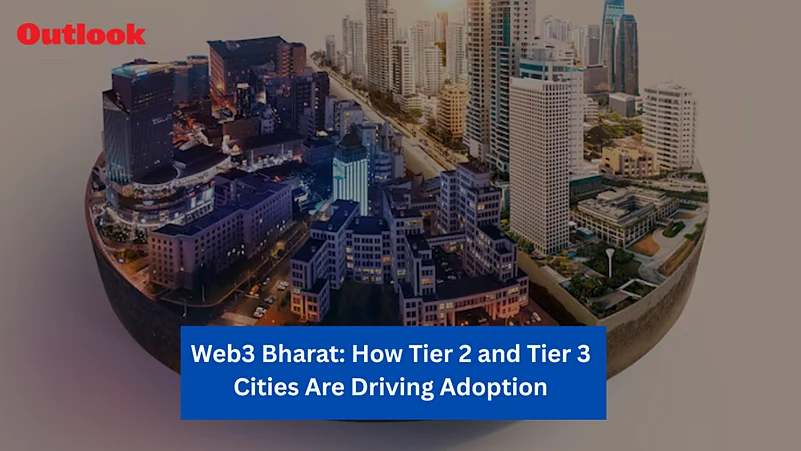For a long time, the crypto and blockchain technology talk in India was mostly happening in metro cities like Mumbai, Bengaluru, and Delhi. But quietly, a revolution is building up in the Tier 2 and Tier 3 cities. These cities are proving to be the unexpected but powerful Web3 adoption drivers in India. With the digital divide narrowing and awareness being higher, the small towns are now contributing significantly towards India's crypto growth story.
Getting Familiar with Web3 and Why It Matters
Web3 is the next generation of the internet, also referred to as the decentralized web. It is based on the blockchain principle and enables people to interact online with no intermediaries like banks, large corporations, or governments having the information in their control. It also includes applications like cryptocurrencies, non-fungible tokens (NFTs), decentralized finance (DeFi), and decentralized applications (dApps). For countries like India with a huge population base, Web3 also introduces not just innovation but also financial inclusion.
Why Tier 2 and 3 Cities Matter
Indian Tier 2 and Tier 3 cities such as Surat, Jaipur, Indore, Patna, Coimbatore, and Guwahati have most of the country's population. With increasing penetration of smartphones and internet in them, interest in technology and digital finance also increases. According to several surveys and exchange reports, there are more first-time users of crypto today from these towns.
One of the key reasons is economic empowerment. Most young people in these cities seek means of earning, investing, and accumulating wealth independent of jobs and banking institutions. Web3, with its vision of decentralized earning paradigms like crypto trading, play-to-earn gaming, and freelancing through smart contracts, resonates with this.
The Role of Education and Awareness
One of the biggest barriers to increasing Web3 adoption has ever been awareness. But interestingly enough, self-learning and online education are transforming this. Young students in Tier 2 and 3 cities are now more and more using YouTube, Telegram channels, and internet forums to educate themselves on blockchain fundamentals, tokens, and NFTs. They aren't waiting for traditional education systems to catch up.
These platforms have noticed this trend and have introduced local content in Hindi, Tamil, Bengali, and other Indian languages to mainstream blockchain concepts among the masses. Local-language content has been a key factor in building trust and familiarity among users from small towns.
Influence of Regional Creators and Local Communities
Yet another reason the Web3 boom has hit smaller towns is the rise of local influencers and content creators. Local YouTubers, bloggers, and teachers who talk about crypto and blockchain in their local languages make the subject more relatable. These creators are more down-to-earth than those from the big cities and therefore enjoy a more trusting following.
In every town, new informal local Web3 communities are arising. These can begin as simple WhatsApp groups but grow to be forums where people share resources, news, and opportunities. In states like Gujarat, Rajasthan, and Kerala, these are already organizing small events, workshops, and meet-ups.
Growth in Entrepreneurship and Innovation
Tier 2 startups too are catching up. Startups are developing NFT collections of art, gaming platforms, and blockchain services from cities which were not previously counted among the tech cities. That is being supported by India's general digital infrastructure like UPI, Aadhaar, and the flourishing of fintech services.
In fact, the affordability and availability of tech talent in these cities make them the ideal laboratories for experimentation and bottom-up innovation. Blockchain-focused accelerators and programs now turn their gaze away from metros to tap this hidden potential.
Digital India and Government Push
The Digital India vision of increased connectivity and digital empowerment has opened up Web3 penetration in small towns. Cheap internet through Jio and improved digital infrastructure have hooked more Indians onto the web than ever before. While India's crypto regulation has been cautious, overall vision for a digital economy and work on a Central Bank Digital Currency (CBDC) show that the government is aware of the potential in blockchain.
Further, various state governments are also becoming interested in blockchain application in government, supply chain, and land registration. Such growing institutional adoption can indirectly build confidence among ordinary users.
Challenges That Remain
There are, nonetheless, issues that still linger. Many individuals in these cities remain unaware of the risks of crypto investments like market volatility and scams. Misinformation, unregulated space, and language barriers are still hindering mass adoption.
Cybersecurity also remains a concern. With greater uptake, comes the higher risk of cyber fraud, especially when individuals are ill-informed about or technically unprepared for it. There is also a virtual gender divide that needs addressing, with fewer women from such regions appearing in the Web3 space.
Conclusion
Tier 2 and Tier 3 cities are no longer just playing catch-up—now, they are charting India's Web3 future. With every expanding wave of digital access and awareness, these cities will be the engines of a decentralized, inclusive digital economy. Web3 Bharat is not just a tech story—it's a social and economic revolution in the making.

















![[2026년 최신판] 토토사이트 순위 추천 기준과 선택 방법 안내 [2026년 최신판] 토토사이트 순위 추천 기준과 선택 방법 안내](https://media.assettype.com/outlookindia/2025-11-27/gto60xat/2026년-최신판-토토사이트-순위-추천-기준과-선택-방법-안내?w=200&auto=format%2Ccompress&fit=max)







